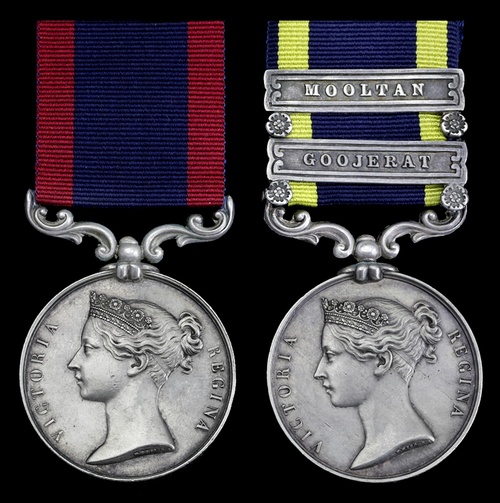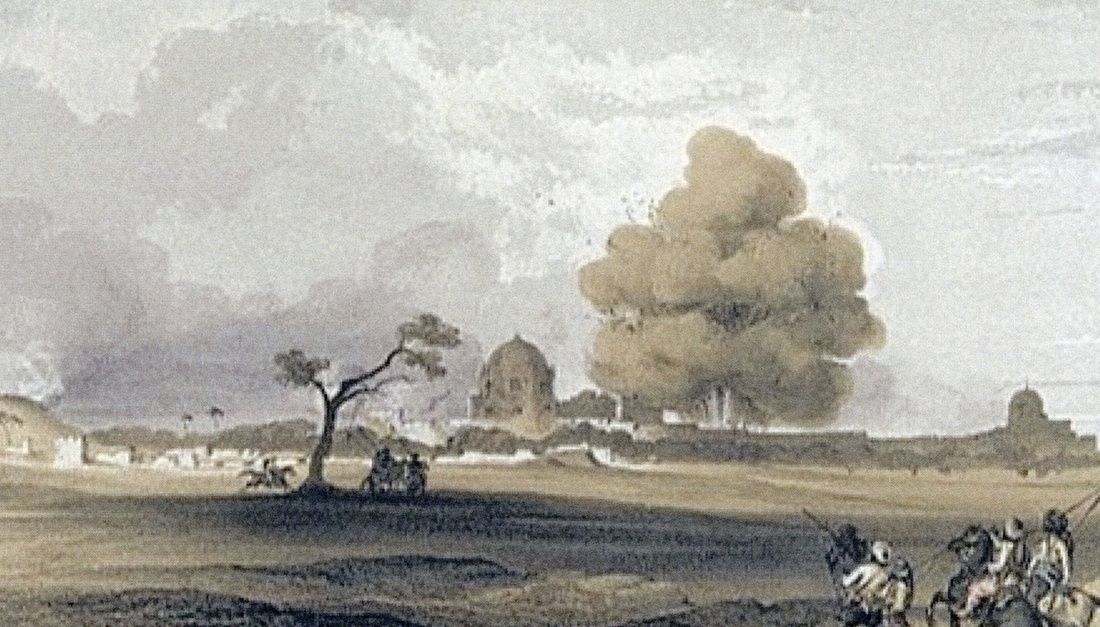Auction: 18003 - Orders, Decorations and Medals
Lot: 309
'The Sappers and Pioneers, under that most able officer, Captain Siddons, did excellent service, and were ever in front to overcome any obstacle.'
Sir Hugh Gough praises Captain Siddons' achievements at Mooltan, January 1849.
The important 'Sikh Wars' pair to Captain H. Siddons, Bengal Engineers; personally selected by Gough to command the Sappers and Miners at the Siege of Mooltan, Siddons' outstanding siegecraft hastened the city's capture, enabling Lieutenant-General Whish to march to Gough's relief at Goojerat
Having worked in Arakan as a civil engineer, Siddons fought bravely at Sobraon on 10 February 1846, hacking through Sikh defences to create openings for the British assault; at Mooltan on 18 January 1849 he undermined the citadel, reducing its walls to rubble and forcing the rebel leader, Diwan Mulraj Chopra, to surrender unconditionally
Sutlej 1845-46, for Sobraon, no clasp (Capt. H: Siddons Engineers); Punjab 1848-49, 2 clasps, Mooltan, Goojerat (Captn. H. Siddons, Engrs. Commg. Sappers & Pioneers), corps on last partly obscured by suspension, the Goojerat clasp sprung from carriage on right side, very fine (2)
Henry Siddons, grandson of the renowned actress Sarah Siddons (1755-1831), was born at Edinburgh in June 1812. Educated at Edinburgh's (now Royal) High School, he began a cadetship at Addiscombe Military Seminary in 1828. After graduating as a 2nd Lieutenant on 11 December 1829 he was posted to the Bengal Sappers and Miners at Delhi, becoming an expert cartographer at the Survey Department. From 11 December 1832 he mapped the country between Rajemahl and the Hooghly river, ascertaining the area's potential for a canal network.
Chittagong
Siddons married his cousin, Harriet Emma Siddons, at Calcutta on 7 July 1834. Three months later he was appointed Revenue Surveyor at Chittagong, one of the most dreaded of all Indian stations, its oppressive climate leading many promising officers to early graves. Siddons must have felt apprehensive as he crossed the Bay of Bengal with Harriet on 13 October. His predecessor as Revenue Surveyor had impoverished a leading native family, causing widespread distrust among the local population. The Reformer of November 1837 described how a routine revenue survey in Chittagong met with violent opposition:
'Lieutenant Siddons and Mr Harvey, who were both on the spot, appear to have been exposed to considerable danger, and it is stated that their lives would have been sacrificed if they had not resorted to the use of fire arms to keep off the mob, who, armed with heavy clubs, were attempting to rush in upon them; in which if they had once succeeded, nothing could have saved their lives.'
Company troops eventually restored order, arresting the ringleaders. Siddons' term of service entitled him to two years' furlough, which he spent in England. Before his furlough ended he voluntarily returned to India, hoping to participate in the 1st Afghan War. He arrived too late to join Sir George Pollock's march on Kabul, but was dispatched to Brigadier Frederick Young's headquarters at Kotah on 25 November 1842 as Adjutant of the Bengal Engineers. He helped suppress a Bundela insurgency by overseeing the destruction of native hill-forts.
In May 1843 Siddons moved to Akyab, provincial capital of the Arakan region, having been appointed Executive Engineer in the Public Works Department. He embarked on numerous projects, most notably the Great Lighthouse on Savage Island, at the entrance to Akyab harbour. Reaching 138 feet, this stone structure cast its light over 14 miles.
Sobraon
Breveted Captain on 29 August 1845, Siddons was serving as Adjutant of the Bengal Sappers and Miners in mid-December when Lal Singh crossed the River Sutlej with a Sikh army of 40,000 men. Sir Hugh Gough, the British Commander-in-Chief, gained pyrrhic victories over the Sikhs at Moodkee, Ferozeshah and Aliwal. Siddons was present at the decisive battle of Sobraon on 10 February 1846, when Gough attacked a well-entrenched Sikh force.
Despite a heavy British bombardment, the Sikh positions at Sobraon held firm and Dick's 3rd Division was driven back in disorder. With axes and fascines, the Bengal Sappers and Miners launched themselves at the enemy entrenchments, crossing a wide glacis enfiladed by Sikh batteries. Hacking through the abatis, they created openings through which the 3rd Light Dragoons passed in single file before charging wildly upon the Sikhs. The resultant British victory thus owed much to the determination and gallantry of Siddons and his comrades.
Lal Singh's defeat enabled Lord Hardinge, the British Governor-General, to impose severe penalties on the Sikh state under the Treaty of Lahore. These included the cession of territory to the British and the payment of an indemnity of half a million pounds. Siddons was appointed Superintendent of Canals west of the Jumna, a position he held until early 1848.
Mooltan
Between July 1848 and January 1849, Siddons commanded the Sappers and Miners at the Siege of Mooltan, a famous operation in which an outnumbered British column under Lieutenant-General Whish invested this strategic city and captured its rebel leader, Diwan Mulraj Chopra. If Whish's siege had failed, the British would have lost the Punjab and possibly even the Indian subcontinent (see Lot 549 of Spink's April 2018 sale of Orders, Decorations and Medals). Sir Hugh Gough personally selected Siddons for the role (see Allen's Indian Mail, 1850). Siddons did not disappoint: in A Year on the Punjab Frontier (1851), Major Herbert Edwardes praised the 'unusual energy' with which 'a noble staff of young engineers' set about assembling the siege-train and its immense matériel.
The obstacles faced by Whish's army are vividly described in Siddons' Journal of the Siege of Mooltan (1849-50). He writes that when the 10th Regiment of Foot attacked Mooltan's walls on the night of 9 September, the lack of heavy-calibre artillery support 'rendered the gallant efforts of the troops useless.' Siddons constructed a series of forward trenches to bring four 18-pounders and four howitzers closer to the enemy ramparts. All efforts were in vain. Sher Singh, commanding the Sikh auxiliaries in Whish's force, treacherously switched his allegiance to Diwan Mulraj Chopra. Whish had no option but to fall back on Bombay and await re-enforcements.
Whish led a brilliant rear-guard action at Al Suraj Khund on 23 September. On 21 December he resumed the siege, his artillery augmented with batteries from the Bombay Presidency. Saps created by Siddons' corps enabled the heavy guns to be brought within eighty yards of Mooltan's walls. This proximity made the British bombardment far more effective, resulting in two large breaches and causing Mooltan's main magazine - containing nearly 800,000 lbs of powder - to explode on 30 December, sending a column of debris over a thousand feet into the air and killing around 800 of Mooltan's defenders.
Diwan Mulraj Chopra continued to defy the British from Mooltan's formidable citadel. Siddons drove saps right up to its walls; on 18 January he undermined the counterscarp with another terrific explosion, breaching the citadel. Threatened with storming, the garrison surrendered unconditionally to Whish four days later. This enabled Whish to march at lightning speed to Sir Hugh Gough's relief at Goojerat, covering nearly 450 miles in a fortnight. By seizing the fords at Wazirabad, Whish trapped the Sikh army on Goojerat's open plain. A resounding British victory followed, bringing the Punjab under Company rule. It is arguable that this outcome stemmed from the quality and ingenuity of the Sappers and Miners at Mooltan.
Siddons died on 26 February 1850 at Portobello, Edinburgh; sold with an extensive file of copied research, including pages from Siddons' Journal of the Siege of Mooltan.
Recommended reading:
Edwardes, Major H., A Year on the Punjab Frontier (London, 1851).
Siddons, Captain H., 'Journal of the Siege of Mooltan', in Corps Journal of the Royal Engineers and EIC Engineers, Vol. I (1849-50), Paper XLI, pp. 419-460.
Subject to 20% VAT on Buyer’s Premium. For more information please view Terms and Conditions for Buyers.
Sold for
£3,500







